History
The city of Caeserea, today called Kayseri, has an important place in the history of the Armenian Church. Once the most important city in central Anatolia, with a population said to be 400000 in 250 AD, it was where St. Gregory the Illuminator grew up, was educated, and became a Christian.
After his conversion of Trdat, king of Armenia, to Christianity in the early part of the 4th century, it was to Caeserea that St. Gregory returned to be formally ordained as a priest, and until the year 373 all the early catholicoi of Armenia were consecrated in Caeserea. The Church
"I am open to correction, but I believe the Church of St. Gregory the Illuminator in the southern quarter of Caeserea to be the only Armenian church in Anatolia where services are still conducted. Erected in 1856, it presents. as might be expected, a rather tawdry appearance today, but the Gregorian priest, whom I visited, still contrives to minister to the 2,000 odd Armenians who (out of a population of 70,000) inhabit the town. Upon his death the church will be doubtless either closed or pulled down as was the case a few years ago with the fourteenth-century church of St. Sarkis".
- E. H. King, Through the Taurus mountains and the Armenian Cilician Kingdom Asiatic Review, 1937, vol. XXXIII.
Since the above was written the Armenian population of Kayseri has dwindled to almost nothing - if the surrounding villages and small towns are counted, there are now perhaps only 20 or 30 individuals left.
However, King's prediction did not come true: the building still stands, and it remains the only operating Armenian church in eastern anatolia. Today there is no resident priest and services are no longer regularly conducted - but to prevent the confiscation of the church as abandoned property, priests travel from Istanbul several times a year to conduct services within it.
Until recently, few - if any - Armenians actually attended these services, but now pilgrimages to Kayseri by Armenians from Istanbul are often organised to coincide with the principle feast days of St. Gregory the Illuminator. Armenian visitors from abroad also sometimes attend.
Description
The church sits within a high walled enclosure that also contains many smaller ancillary buildings, mostly now derelict and roofless. The church is a relatively recent construction, being built in 1856. There are older dates on some of the surrounding buildings, so there was probably an older church on the same site. In the 1990s the interior was renovated, and the altars re-gilded.
The design of the church is a rectangular basilica with a nave and two aisles, The interior has 6 free-standing columns, 4 of which support a large cupola with a drum.
This design type is common in Armenian churches built from the mid 17th century onwards, and was heavily influenced by post-Byzantine Greek churches. However, the standard design is altered here by having shallow rectangular arms that (on the lower level only) extend out from middle of the north and south sides of the church, giving the groundplan of the church a cross shape.
The church has a main entrance on its west side - a large belltower stands in front of it, forming a porch. There is a secondary entrance at the west end of its south side, plus a third entrance above this secondary entrance that is reached by an external staircase and gives access to a large gallery inside the church, at its western end.
This gallery was probably intended for women only. Its wooden floor is divided into rectangles, each with a number, marking the position where the rug of an individual worshiper would have been laid.
With the exception of the columns, the interior is entirely covered in plaster decorated with a mixture of motifs - European, Turkish, and Armenian - of little real artistic merit but very much of their time period. On the pendentives of the dome are depicted the four Evangelists: Matthew, Mark, Luke, and John, together with their attributes.
The nave and two aisles each end in an apse containing an altar. These highly ornate altars glisten with wood and plaster gilded in gold. Each contains a painting - these are recent works (dating from the year 1999?) that replaced the 19th century originals.
The painting within the north altar is the most interesting. It depicts the vision of Saint Gregory: four columns of fire, with capitals of cloud, each surmounted by a flaming cross, carried arches that supported a dome of clouds, topped by a throne and the cross of Christ shimmering in divine light. In the painting, the artist makes an explicit connection between this vision and the traditional domed form of Armenian churches.
|
|
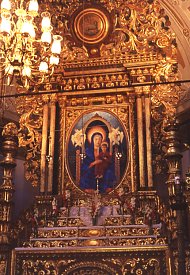 10. The main altar of the church | 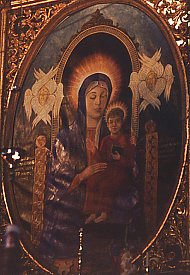 11. Painting within the main altar | 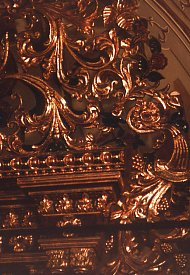 12. gilded woodwork on the altar | |
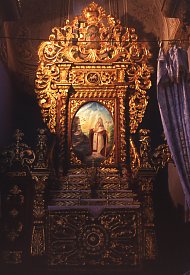 13. The south altar of the church | 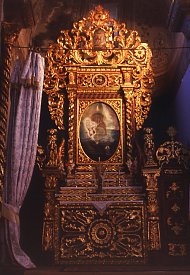 14. The north altar of the church | 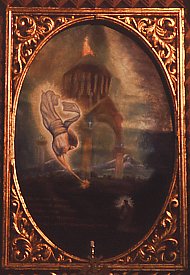 15. Painting within the north altar |
|
There are now rows of benches for worshipers to sit upon, but this is a recent innovation - in the past they would have either stood or kneeled upon a floor covered with carpets. The engraving below, from the 18th century and titled "Worship according to the Armenian Church", depicts this sort of arrangement.
|
|